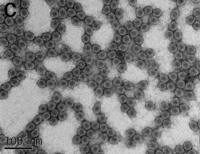
Photo from wikipedia
A hallmark feature of (+)-strand RNA viruses of eukaryotic cells is that progeny (+)-strands are accumulated 100-fold over (-)-strands. Previous experimental evidence suggests that in brome mosaic virus (BMV), a… Click to show full abstract
A hallmark feature of (+)-strand RNA viruses of eukaryotic cells is that progeny (+)-strands are accumulated 100-fold over (-)-strands. Previous experimental evidence suggests that in brome mosaic virus (BMV), a plant-infecting member of the alphavirus-like superfamily, the addition of RNA3 and specifically translation of the wild type (wt) coat protein (CP) gene, contributes to increased accumulation of (+)-strands. It is unclear whether this stimulation of (+)-strand accumulation by CP is due to direct regulation of viral RNA replication or RNA stabilization via encapsidation. Analysis of BMV progeny RNA in Nicotiana benthamiana plants revealed that expression of RNA3 variants that did not express wt CP led to a severe defect in BMV (+)-strand accumulation. Plus-strand accumulation could be rescued when CP was complemented in trans. To verify whether stimulation of (+)-strand accumulation is coupled to encapsidation, two independent mutations were engineered into CP ORF. An N-terminal deletion that prevented CP binding to the viral RNAs resulted in a severe reduction of BMV (+)-strand accumulation but stimulated (-)-strand accumulation over wt. On the other hand, a C-terminal mutation affecting CP dimerization caused a significant decrease in (+)-strand accumulation but had no detectable effect on (-)-strand accumulation. Nucleotide sequences in the movement protein-coding region were also found to contribute to (+)-strand accumulation, in part by providing packaging signals for efficient RNA3 encapsidation. Overall, these results show that RNA encapsidation is a significant determinant of BMV RNA intracellular accumulation.
Journal Title: Phytopathology
Year Published: 2019
Link to full text (if available)
Share on Social Media: Sign Up to like & get
recommendations!